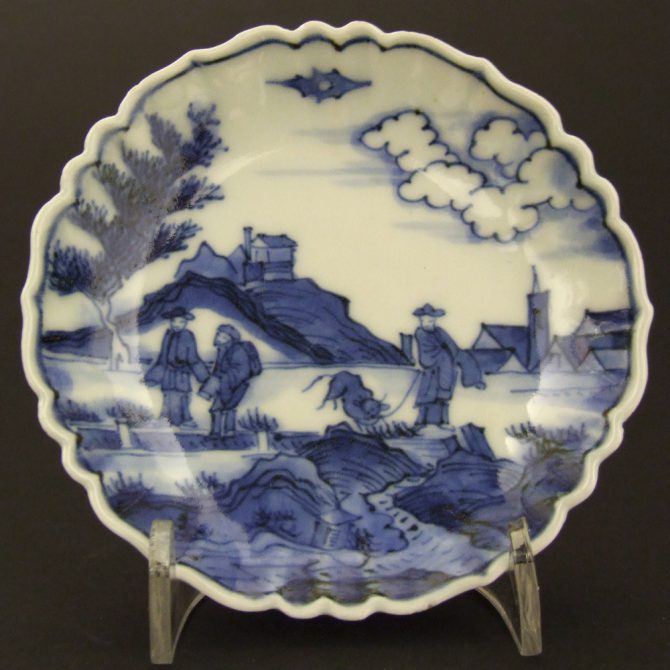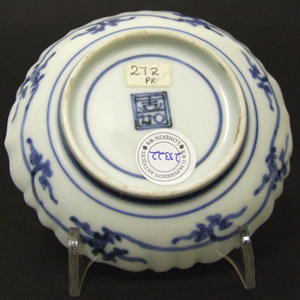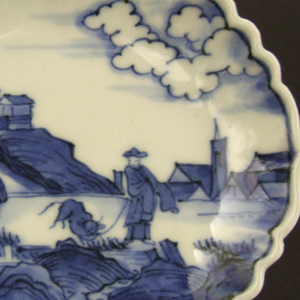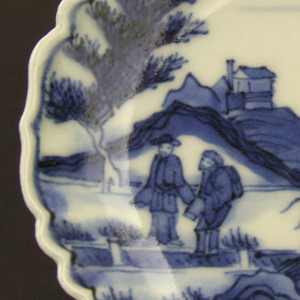
ARITA c.1700 – 1740 Japanese Porcelain
An Unusual Small Japanese Blue and White Porcelain Dish, Arita Kilns c.1700-1740. Decorated in The Style of The Dutch Delft Pottery Decorator Frederik Van Frytom (1632-1702). The Scene is is Known as Deshima Island but is Probably a View of Holland.
SOLD
- Condition
- Perfect.
- Size
- N/A
- Provenance
- The John Drew Collection of Chinese and Japanese Ceramics John Drew was born in 1933 in Tideswell, Derbyshire, where his father was curate. The family moved to Norfolk whilst he was still a baby and his father became the rector of the parish of Intwood and Keswick. He was educated at Sedbergh School and after National Service in the R.A.F. being taught Russian, he went to Queens College, Oxford to read Greats (Classics). He spent nearly all his working life in various African countries as an archivist, moving to a post at Cape Town University in 1978. He remained in Cape Town after his retirement until his death in 2006. He had a great love of the English countryside (but not the climate) and this is shown in many of the pieces he collected. His taste was varied and ranged from Neolithic right through to the 18th Century. When we sent photograph to his home in Cape Town of pieces we thought he might be interested in, he would write long funny well observed letters back, wanting to add many of the items to his growing collection. Over the years we got to know him better and better, and during the last few years it was very rare for him to not want all the pieces we offered him. We knew his taste, even though his taste was so varied. This was in no small part because he had a very good eye and it was a pleasure finding things that interested him, because they were also very interesting to us. He never got to put his collection on display, something he hoped to do while on retirement in England, so it is with a mixture of pleasure and sadness that we offer these pieces from his collection . Each piece has a John Drew collection label, so when the collection is split up there will be some lasting record of the love and hard work he put into his two decades of collecting
- Stock number
- 23322
- References
- For a Japanese porcelain version of this pattern see : Ko-Imari Porcelain From The Collection Of Oliver Impey (Barry Davies Oriental Art Ltd, London, 1997) pages 136-137, item 75. For Chinese porcelain examples see : Tau Co Ca Mau, The Ca Mau Shipwreck 1723 - 1735 ( Nguyen Dinh Chien, Na Noi, 2002 ) Plates 27 - 30. Made in Imperial China, 76,000 Pieces of Chinese Export Porcelain from the Ca Mau Shipwreck, Circa 1725. Sotheby`s Amsterdam, 29,30 & 31 January 2007, lots 223 to 233.
Information
This dish is unusual in that it is of a very small size and is of barbed form. It might have been used as a saucer but I have not seen teabowls of this size.
Japanese, Arita Kilns c.1700-1740 the other Chinese Export Porcelain, Decorated in The Style of The Dutch Delft Pottery Decorator Frederik Van Frytom (1632 - 1702). The Scene Used to be thought of as Deshima Island However it is now Thought to be a View of Holland.Plates and Dishes of this Pattern were Recovered from the Ca Mau Shipwreck. See Stock 14792 and also History.
Frederik Van Frytom :
The Dutch artist Frederik Van Frytom (1632 - 1702) was an important painter of Delft pottery, his style of painting fits very well within the 17th century Dutch landscape tradition, it includes typically Dutch scenes, rustic landscapes with small bridges, pollarded willow and cows scattered about small fields. His ceramic painting technique was individual, more akin to painting than merely filling in a design on a ceramic body. Van Frytom`s connection with oriental ceramics stems from a series of small blue and white Delftware dishes painted by him that were made for the Tea-Ceremony in Japan, the bases of which were marked MB and dated 1684 (See Frederik Van Frytom 1632 - 1702, Life And Work Of A Dutch Pottery-Decorator, A.Vecht, Scheltema and Holkema NV, Amsterdam, 1968). The best known of Van Frytom`s designs is the so-called Deshima Island pattern, now known to be a view of Holland. Porcelain plates of this pattern, as well as related designs, were produced at the Arita Kilns in Japan and then in China at the Jingdezhen kilns, related designs also occurs on Chinese soft-paste porcelain. Plates and dishes of the so-called Deshima Island pattern dating to the Yongzheng period (1723-1735) were sold at Sotheby`s Amsterdam Sale of Chinese Porcelain from the Ca Mau Cargo, "Made in Imperial China". This Western style was then re-used, probably via Japanese or Chinese interpretations, in England at The Bow Factory using soft-paste porcelain, at least some of these Bow pieces closely relate to Chinese soft-paste porcelain versions of the design. However, the Chinese soft-paste examples are quite late in date, so it might well be possible that they are based on the Bow examples that are copying the Japanese or Chinese versions of the Delft. A complex and somewhat confusing inter-connection of design and trade.


